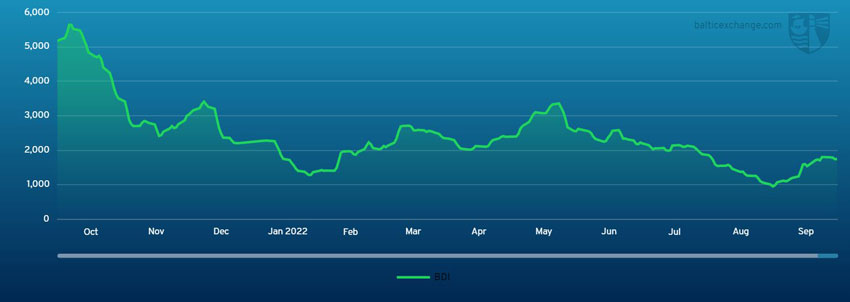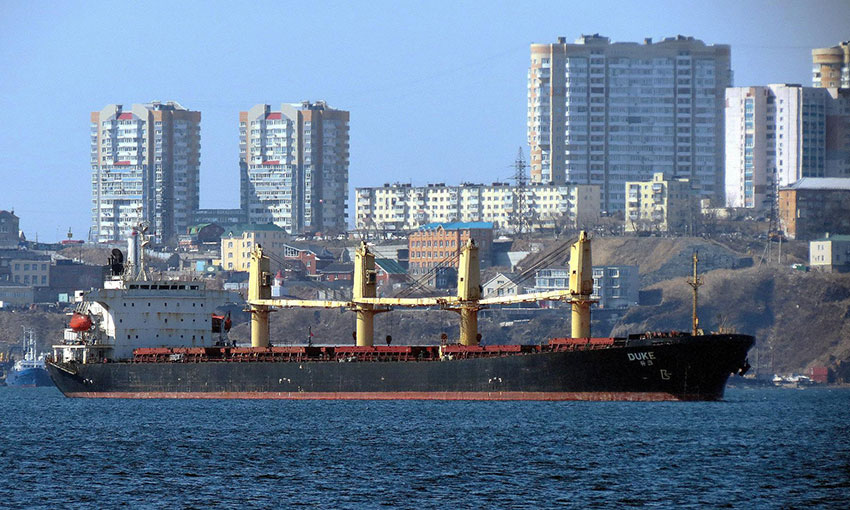THE Baltic Dry Index ended last week flat after several weeks of increases. The BDI on Friday 30 September was 1760, up just three points from the previous day and down 3% on the previous Friday’s number.

Capesize
The Capesize market failed to push through to higher values this week as lower activity in the Pacific hampered efforts. The Capesize 5TC closed the week at US$16,214. The Atlantic basin has been looking well supported with fixture values continuing to climb. However, a question mark remains as to whether the overall activity is enough to pull the wider market along. The North Atlantic has been on diverging paths this week with the Pacific as the transatlantic C8 now prices at US$20,167 to the transpacific’s C10 at US$9,159. Only at the end of last week were the two basins trading at parity. The Pacific market major charterers loading out of West Australia were seen having to pay up last week. But this week rates were all falling in their favour as the C5 dropped -2.205 week on week to settle at US$8.035. Severe weather concerns that could affect vessel sailing schedules were largely isolated to the Philippines and Florida regions with Typhoon Noru and Hurricane Ian. With a large number of Hurricanes and Typhoons in recent weeks, odds are that the weather disruption is likely to continue.
Panamax
It proved to be a real Atlantic/Asia divide this week for the Panamax market. The Atlantic market advanced all week, primarily driven by solid grain demand both for transatlantic and fronthaul trips. Later in the week saw some decent levels of minerals too, although there remained quite a gap on rates between the different cargo trips. Even the smaller LME types were able to achieve US$18,000 a few times for grain TA rounds, with mineral round voyages discounted a little off this. It was a lethargic Pacific market this week, except for a minor push midweek from NoPac and Australia destination Japan, with rates returning softer overall. An 82,000-dwt conceding mid US$15,000’s midweek for a NoPac trip, but this perhaps is a one off with levels of US$17,000 more akin to market. Indonesia coal demand diminished week on week with smaller/older types discounting rates in order to cover prior to Asian holidays.
Ultramax/Supramax
A rather tempered week overall for the sector. With the upcoming holiday in China demand waned as the week ended with less fresh enquiry in Asia. From the Atlantic, by contrast, general sentiment remained positive. However, some felt it was being increasingly positional as the US Gulf lacked fresh enquiry and rates were put under pressure. Limited period activity surfaced, but a new building 63,000-dwt open China was heard to have fixed in the low US$18,000s for one year. In the Atlantic, a 63,000-dwt was fixed for a trip from East Coast South America for a transatlantic run at US$31,000. There was better enquiry from the Continent – Mediterranean. A 60,000-dwt open Otranto fixed a trip to the US Gulf-US East Coast at US$25,500. From Asia, a 58,000-dwt was heard fixed from Japan to the Atlantic in the upper teens. From the South, as limited fresh enquiry surfaced, 56,000-dwt open Xiamen was heard fixed via Indonesia redelivery China at US$14,450.
Handysize
A split week whilst the Atlantic saw gains with upward pressure on rates from key areas such as South America. The Asian arena was decreasing sentiment as the upcoming holiday saw lower enquiry coming into the market. Period activity remained limited, but a 37,000-dwt open Liverpool was heard fixed for 11 to 14 months trading at 105 percent of the BHSI. Strong demand from East Coast South America saw a larger handysize in the upper US$20,000s for transatlantic runs. Elsewhere, a 37,000-dwt open Baltic end September was fixed for a trip to the Far East at US$17,000. Limited action from Asia, but a 36,000-dwt was in the mid teens for a trip delivery Tuticorin via Indonesia to China. A 31,000-dwt open West Australia was heard fixed for a salt run in the low US$20,000s. All eyes on the upcoming week to see how the holidays will affect the market.
Clean
In the Middle East Gulf this week all Baltic TC sectors have suffered a decline in freight levels. Lack of open activity has been the trend and APPEC may have played a role in that. TC1 lost 39.37 points to end up at WS194.38. For TC20, an LR2 heading west dipped below US$4,000,000 for the first time since mid-July this year. On the LR1s, TC5 came off to WS216.43 (-67.86) and a run west (TC8) dropped from US$,4,250,000 to around US$3,500,000. Similarly, the MRs of TC17 lost 90.83 points to end up at WS266.67 by the end of the week.
West of Suez LRS have been subject to inactivity again. TC15 had been widely reported fixed at US$4,250,000 midweek and softening sentiment has led the index down through that to US$4,100,000 at present. On TC16, LR1s held steady around WS210-215 all week.
On the UK-Continent MR Supply has continued to outweigh demand and subsequently TC2 lost 32.22 points to WS267.22 and similarly TC19 shed 33.58 points to end up at WS275.71
In the US Gulf MRs have continued to yo-yo with activity coming in lightning strikes followed by silence. The TC14 and TC18 indices have reacted in line with this behaviour. Despite this, TC14 is still earning around US$30,000-35,000 /day TCE and TC18 around US$50,000-55,000 /day at present freight levels.
The MR Atlantic Triangulation Basket TCE lost US$4936 from US$56,286 to US$51.350.
On the Handymax, in the Mediterranean TC6 has continued up this week to around the WS325 mark where it looks to have plateaued. In the Baltic TC9 has also climbed this week (+26.43) to WS351.43 reacting to the increased Handymax demand in North West Europe.
VLCC
VLCC rates peaked at the end of last week and have fallen daily this week. The 270,000mt Middle East Gulf/China route is now 18 points lower than a week ago at about WS85 (a round-trip TCE of US$50,100 per day), while the rate for 280,000mt Middle East Gulf/USG (via Cape of Good Hope) had six points shaved off to just below WS47.5.
In the Atlantic, rates for 260,000mt West Africa/China fell 13.5 points to between WS86.5-87 (US$52,800 per day round-trip TCE). For the 270,000mt US Gulf/China market rates fell a further US$668,750 to US$9,618,750 (showing a round trip TCE of US$41,500 per day).
Suezmax
Rates for 135,000mt Black Sea/Augusta eased two points to the WS 182.5 region (a round-trip TCE of US$77,200 per day, which is US$800 per day more than a week ago). Meanwhile, for the 130,000mt Nigeria/UKC trip rates eased 3.5 points to a little above WS135 (a round-trip TCE of about US$42,500 per day which is marginally up from last week).
In the Middle East the rate for 140,000mt Basra/West Mediterranean has held at the WS66-66.5 mark, with Repsol now being reported to have taken a Frontline Suezmax at WS66.5 Basra/Spain loading mid-October.
Aframax
The Mediterranean market made further gains this week with the rate for 80,000mt Ceyhan/West Mediterranean 14 points firmer at WS201 (a round-trip TCE of US$53,600 per day). In Northern Europe, a flurry of activity enabled owners to push the rate up and
the latest assessment for the 80,000mt Hound Point/UK Continent trip is up 31.5 points at between WS195-197.5 (a daily round trip TCE of US$65,500 per day). For the 100,000mt Primorsk/UK Cont route the rate is now assessed 34 points higher at about WS 220 (a round-trip TCE of US$74,200 per day).
Across the Atlantic, the market continued to weaken with the rate for 70,000mt EC Mexico/US Gulf falling 35 points to about WS220 (a round-trip TCE of US$44,500 per day) while the rate for the 70,000mt Caribbean/US Gulf trip lost 24 points to WS 214-215 level (a daily round-trip TCE of about US$39,600). For the transatlantic route of 70,000mt US Gulf/UK Continent, the rate shed nine points to between WS205-207.5 (showing a US$38,200 per day round-tip TCE, which is in line with a week ago).

